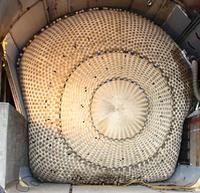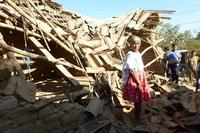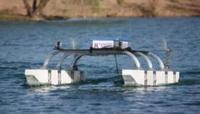-
Pattern of large earthquakes on San Jacinto fault identified
The San Jacinto Fault (SJF) Zone is a seismically active, major component of the overall southern San Andreas Fault system; researchers have mapped evidence of past ruptures consistent with very large earthquakes along the Clark Fault, an individual strand associated with the SJF
-
-
Containing a tunnel flood with an inflatable giant plug

Researchers have developed a giant plug to contain tunnel floods; the plug inflates (with water or air) to dimensions of roughly 32-feet-long and by 16-feet-wide, and holds 35,000 gallons, about the same capacity as a medium-sized backyard swimming pool
-
-
2011 disasters: $116 billion in insured losses, record economic losses of $370 billion
Figures confirm that 2011 was the second-highest catastrophe loss year ever for the insurance industry: 2011 saw the highest economic losses in history, at $370 billion; the insurance industry experienced the second-largest insured losses ever, at $116 billion; 2011 also brought the highest insured earthquake losses, at $49 billion; flooding in Thailand resulted in the highest insured losses ever for a single flood event, at $12 billion
-
-
Haiti implements national plan for disaster risk reduction
The government of Haiti and the UN Development Program launch Haiti’s National System for Disaster Risk Reduction program; the UN says this is one of the first times that a developing country has taken advance measures to reduce the vulnerability of its people and economy to future earthquakes
-
-
A swarm of small satellites to deflect menacing asteroids
New research suggests that the best way to divert an asteroid hurtling toward Earth is using a swarm of relatively small satellites flying in formation and cooperatively firing solar-powered lasers onto an asteroid; this would be a more effective way than the current methods being contemplated, which are focused on large unwieldy spacecraft
-
-
Mexico has an earthquake warning system, why not California?

Mexico has a functioning and apparently life-saving earthquake warning system in place; California’s system is stuck in a permanent test phase due primarily to lack of funding
-
-
Planetary exploration vehicle for earthly search-and-rescue missions

A researcher develops a NASA-sponsored autonomous lake lander for the purpose of exploring lakes on distant planets; this mission is many years in the future; in the meantime, the vehicle is ready to deploy on missions related to defense and security, such as harbor surveillance and cleanup operations of littoral munitions dumps and mines; it is also ideal for search-and-rescue operations in oceans, lakes, and hazardous environments, as well as for environmental research projects
-
-
Companies team up to develop carbon capturing
Three companies have teamed up to build a low-carbon, coal-based power plant in Scotland; the plant will include a carbon-capture and storage; with more than 90 percent carbon capture, the coal feedstock plant will generate extremely low-carbon electric power and also produce hydrogen gas for commercial use
-
-
The Red Cross, emergency response, and Twitter
Social media has become such an integral part of our lives that emergency responders are now turning to Twitter and Facebook to gain valuable information during natural disasters or crises
-
-
Millions of Americans at risk of flooding as sea levels rise
Nearly four million Americans, residing in a combined area larger than the state of Maryland, find themselves at risk of severe flooding as sea levels rise in the coming century, new research suggests; in terms of population, Florida is the most vulnerable, closely followed by Louisiana, California, New York, and New Jersey
-
-
iPads allow judges to sign warrants anywhere
Getting local judges to sign last minute warrants just got a lot easier with iPads
-
-
Brown graduate students help bankrupt city create disaster plan
To help the cash-stricken city of Central Falls, Rhode Island, thirty graduate students from Brown University have banded together to help create a disaster preparedness plan
-
-
Study shows violence against women increases following disasters
A new study shows that in the aftermath of a devastating natural disaster domestic violence against women tends to increase
-
-
Tornadoes will not deplete FEMA disaster fund
The latest series of tornadoes that raged across the Midwest and South will not deplete the U.S. disaster fund, which was only recently reloaded by Congress last year, officials said
-
-
Tighter regulation of industry’s disaster preparedness required
Before 11 March 2011, Japan was held up as a paragon for preparedness; they had a national readiness plan, regular disaster drills, and strong civic engagement; the Fukushima disaster exposed a disturbing reality: search and rescue efforts were delayed, shelters ill-equipped, and supply chains broken; worst of all, there was confusion about who was managing the nuclear accident — the power company TEPCO or the Japanese government; information, when forthcoming, was sometimes contradictory
-
More headlines
The long view
Risk Assessment with Machine Learning
Researchers utilize geological survey data and machine learning algorithms for accurately predicting liquefaction risk in earthquake-prone areas.
